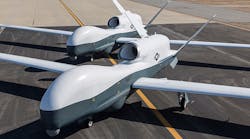Northrop Grumman Corp. is working to convince the Pentagon that it’s solved long-standing manufacturing flaws that resulted in defective wings for the Navy’s new Triton reconnaissance drone, as the service prepares to ask defense officials to approve the aircraft’s production.
The flaws — and Defense Department requests for plans to fix them dating back to 2013 — haven’t been previously disclosed. The Navy wants to spend as much as $10.2 billion for production of 68 of the pilotless aircraft, including $4 billion by 2021 in the “low-rate initial production” phase. The Triton is designed for 24-hour surveillance from an altitude as high as 56,000 feet. Australia also plans to buy the drone.
Questions about Northrop’s quality control abilities might attract special attention because the Air Force has picked the Falls Church, Virginia-based contractor to build its new B-21 bomber, a largely classified aircraft that may cost $80 billion.
The Triton is based on the Global Hawk drone that Northrop builds for the Air Force but with a de-icing system and strengthened wings. Manufacturing of those new wings by a subcontractor has generated the unpublicized quality-control issues during the Triton’s development phase.
Northrop received a Corrective Action Request from Pentagon quality inspectors in May 2013 “due to recurring defects in manufacturing the composite wing spar,” Sean Burke, the Navy’s program manager for Triton, said in an e-mail.
The Defense Contract Management Agency said it issued the first citation because of “wing non-conformances” by a subcontractor that included “bonding issues, hole drilling and material handling.” A year later, the issue was elevated to senior Northrop management because of insufficient progress, the agency said.
The citation was expanded to include “overall quality and defect reduction,” according to Burke, who said “extensive progress has been made” since then.
The Navy, Northrop and the Defense Contract Management Agency are making efforts to have the citation withdrawn by August, according to Burke. He said the Navy can recommend that initial production proceed in any case because a corrective action plan is in place.
Between July 1 and Sept. 30 the Pentagon’s Defense Acquisition Board is scheduled to review a move from development to low-rate production, according to the Navy’s Triton program office.
“The Northrop Grumman team, in close collaboration with our Navy customer and industry teammates, has successfully worked through some initial challenges in the areas of early wing production and software, all of which are currently now moving forward to plan,” company spokesman Randy Belote said in an e-mail. “We are confident we are on track” deliver operational capability in 2018.
The Defense Contract Management Agency is evaluating Northrop’s corrective actions and “currently projecting an August 2016 closure date” on its action plan, Mark Woodbury, a spokesman for the agency, said in an e-mail.
By Tony Capaccio




